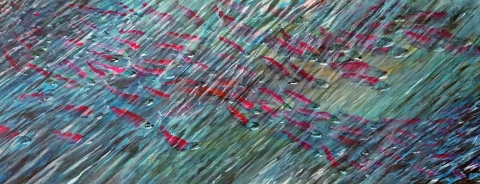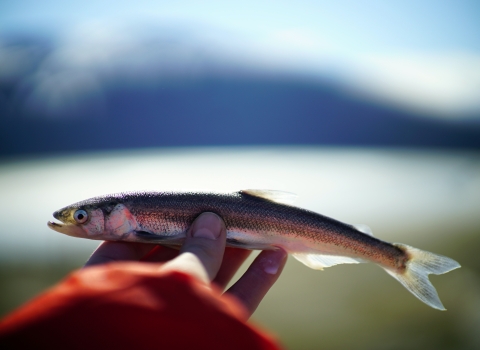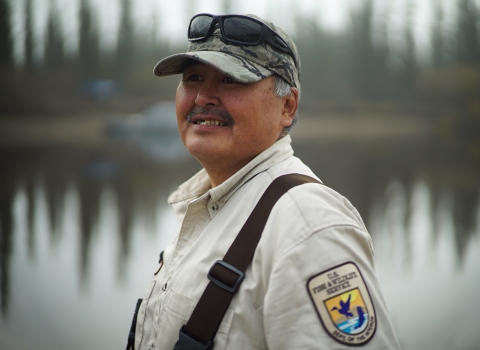About midway down the Alaska Peninsula is Chignik, one of three small villages situated in the Chignik River watershed. For outsiders, this may seem an austere and even unforgiving place: steep mountains plunge to deep fjords and extensive lagoons. The weather can be extreme, and fog and mist typically shroud the land between storms. The population is sparse.
But for Orville Lind, his family and the Alutiiq people who are his relatives and friends, Chignik was a paradise, a landscape rich in natural resources and steeped in cultural significance. The Sugpiaq (which translates to “Real People”) have lived here for millennia, and their attachment to the Chignik bioregion is more than physical or social.
“We’re deeply connected to the food that the land and sea provide. It’s not just a matter of sustenance — it’s a spiritual connection, one that defines the health and well-being of our people. When we harvest food from Mother Nature, provided by our creator, we are honored by it.”
Orville was born to Fred and Annie Lind in Chignik, which means “Big Wind” in the Sugpiaq language. His father was village chief. Chignik Lake at that time had about 120 residents. In the early-1900s the tribes moved up to Chignik Lake during fall and winter months, and then back to Chignik Lagoon for summer fishing months until the tribe began to settle at the lake year round.
“There were more resources there and they were more accessible, especially the salmon. Also hunting trapping was much better during fall and winter months,” recalls Orville.
Salmon were both the dietary staple and the focus of community life at Chignik Lake. All five species of Pacific salmon — Chinook, Sockeye, Coho, Chum and Pink — were harvested. Each had its particular season, and virtually everyone in the village spent their waking hours between late spring and late summer harvesting the fish, preparing them for storage and eating them, of course.
Each species had particular characteristics and taste profiles. Chinook and sockeye were valued for their high fat content and rich flavor, and chum were the usual “dog salmon,” also valued by some, also dried in quantity to sustain the teams of sled dogs that were the primary means of winter transport for village residents. Pink salmon — typically considered lower in value by modern commercial fishermen — were also highly esteemed.
“I personally think pinks dry better than the other species. I really still enjoy eating them and other salmon with bear fat or seal oil.”
And salmon were by no means the only resource. Community residents harvested marine mammals, upland birds like ptarmigan, waterfowl, crane, moose, caribou — even brown bear.
“A limited number of brown bears were taken by specific families and the meat was salted for consumption,” recalls Orville. “We knew through the long term observation of the seasons when to harvest particular species. Our lives though observation were shaped by the ptarmigan turning white, the salmon turning red, the waterfowl heading south on their fall and returning during spring migrations.”
Life in Chignik Lake required all hands and a concerted community effort for survival.
At the age of 9, Orville was hired as a deck hand on his brother’s commercial salmon boat, and later on — at age 17 — he became the captain of his brothers vessel for a while. Commercial fishing brought a hard-fought prosperity to Chignik Lake, and Bristol Bay and Orville loved the work; he continued fishing for more than four decades.
But his mother also made sure his horizons stretched beyond Chignik Lake, allowing him to go to high school in Anchorage in 1969 while his brothers and sisters attended Mt. Edgecumbe High School in Sitka and Chemawa High School in Oregon. Community life at Chignik Lake and the world beyond, Orville understood, was inextricably linked; and if native communities were to thrive, they had to actively engage the larger society and help shape its direction.
Orville remembers “As village chief, my dad was firm but fair — a good leader.” There were village members who were picked to watch out for poor behavior in the village, which was why, as a young man, growing up in Chignik Lake was such a good place to live. His dad passed when he was 12.
At the age of 18, Orville was elected Village Chief and that challenge taught him a lot. “We had family gatherings, culture camps or festivals essentially, where the elders taught youth the spiritual significance of the animals that sustained us, and how to track animals, skin seals, and harvest and clean fish.” Life there was healthy and productive for everyone.
He joined the U.S. Fish and Wildlife Service in 1991, first as a Village Refuge Technician and later as a Refuge Ranger and Research Vessel Captain at Alaska Peninsula and Becharof National Wildlife Refuges. He also served as a steel shot, bear safety, firearms, and boat safety Instructor for both the U.S. Fish and Wildlife Service and the Alaska Native Science Engineering Program.
In 2014 he became the Native Liaison in the Office for Subsistence Management, a position he still holds. In this capacity, he is the Service’s primary contact for Alaska’s 229 federally recognized tribes and native corporations, helping determine and implement federal subsistence take regulations on federal lands; he also serves on the interagency staff committees charged with developing recommendations for regulating the state’s rich wildlife resources and as the Native Way of Knowing Instructor for the Alaska Native Relations training which engages and introduces new Federal employees to Alaska Native Cultures (video).
Orville acknowledges that his job is demanding — but also immensely rewarding.
“Subsistence hunting and fishing are as essential to Alaskan native cultures as the preservation of language,” Orville says.
“The challenge is in reconciling the needs of all Alaskans with resource realities, and educating people at every step. We’re facing dramatic changes in Alaska — in caribou and bird migrations, in salmon populations and trends. It’s a critical time. There are some positive developments, but it’s clear that we’re all going to have to work together to preserve what we have.”
Orville’s colleagues laud his contributions to the Service, native communities and the fish and wildlife of one of the planet’s last best places.
“He just connects with people,” says Kevin Painter, a U.S. Fish and Wildlife Service Regional Interpretive and Environmental Education Specialist who has worked extensively with Orville.
“One day he may be working with the Haida or Tlingit in the southeast part of the state, and the next he may be in an Inupiat village in the Arctic. He’s simultaneously professional and humble, extremely competent and outgoing. He’s a tremendous asset to the Service.”
Additionally, notes Kevin, Orville is a highly accomplished artist.
“He’s a phenomenal carver and painter,” Kevin says. “Even his sketches are deeply detailed and powerful, reflecting both his culture and the innate qualities of our fish and wildlife.”
Orville is also a poet, and his verse speaks directly to his culture, his life’s work, and his love for Alaska. Observation is a skill he learned as a child. He wrote one poem after he took a walk with his grandchild:
Tracks left behind are trails of stories untold
For those who believe in all living spirits
Only then will the stories unfold
Orville explains, “It means when we become connected to the outdoors, we grow within ourselves to just listen how and when Mother Nature’s spirit speaks to us. In the interior of Alaska, the moose is particularly revered by the people. In the Arctic, it’s the whale, walrus and caribou. On the Alaska Peninsula, it’s salmon bear and seals. But it’s all the same thing. We believe it’s all one, that we are all connected. We believe it was all given to us for a purpose, and that we are part of it. In the end, I can only say Quyana — which in Sugpiaq, means ‘Thank you.’ ”
How long have you been with the U.S. Fish and Wildlife Service?
Since September 9, 1991
What do you think people would find most surprising about your job?
That native people have a voice. That wasn’t always the case. But Executive Order #13175, which was issued, requires federal government to government outreach and coordination with all tribal governments, and native corporations. They have an opportunity to work together with agencies in how their subsistence resources is managed
How do Alaska’s wild places inspire you?
They have inspired me since my uncles began teaching me as a child. They didn’t talk much, but taught me how an animal’s tracks can tell you its species, size, whether it was walking, trotting or running. Those skills helped me understand the wild, but they also helped me understand people. You can tell a lot just by looking listening or observing.
What’s your foremost concern for Alaska’s wildlife?
That we don’t have enough people properly managing our resources. Wherever I go throughout the state, people talk to me about unfamiliar aircraft or boats in the rivers and along the coast, about people leaving trash behind or harvesting animals and fish they shouldn’t. I’ve always promoted law enforcement, and what I’ve seen lately worries me that we may be not doing enough. On the other hand, we’re making good progress educating the youth, which gives me hope.
When I’m not at work, I’m…..
…teaching my grandchildren about traditional values, how I grew up, spending time with them without cell phones or IPads. I’m visiting with elders and we’re praying together. I’m painting wildlife and fish, particularly salmon. It was a skill that came to be early in my life, and grew from observation. Each of my paintings tells a story about the wildlife and people I whole heartily value.
What’s the greatest misconception people have about Alaska?
I hear people talk about the vast spaces and pristine lakes they see, however, last year, a friend sent me photos of thousands of dead salmon. They died because the water was too warm. Our environment is changing, and more and more people come to Alaska each year. They don’t know the challenges and tragedies we face — I believe Alaska is the last frontier, and we all have to work together to preserve it.
What’s your most treasured memory regarding Alaska or your job?
Probably that I have the privilege and honor of assisting subsistence users put food on the table. Also, because I’m not able to do much subsistence hunting or fishing myself these days, that people share subsistence food with me. It’s incredibly fulfilling either way, and something I and my family cherish deeply.
What advice would you give people interested in a career with the U.S. Fish and Wildlife Service?
That it’s mission is similar to my upbringing, a good career because I choose it to be, if you want to make a difference. That’s why I joined in 1991. People didn’t know the hunting and fishing regulations existed, and couldn’t understand why they were being penalized. That has changed, and there is much better communication and coordination between the communities and the agencies today
What wildlife species do you find most fascinating?
It is not one alone. It’s all of them. TOGETHER. They all are part of us.
In Alaska we are shared stewards of world renowned natural resources and our nation’s last true wild places. Our hope is that each generation has the opportunity to live with, live from, discover and enjoy the wildness of this awe-inspiring land and the people who love and depend on it.








